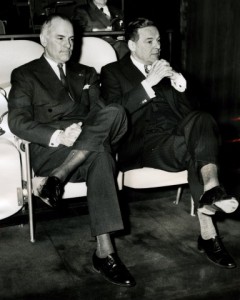With summer weather upon us, nothing will allow the man about town to remain cool in the warmest temperatures like the seersucker suit. I wore a three-piece model — what I call the “full Atticus Finch” — to the offices of The Daily Caller this Tuesday.
Seersucker is a thin, puckered, all-cotton fabric and has been a staple of men’s suiting since the early 1900s. The cloth itself goes back to the British Empire. Seersucker was popular in Britain’s warm weather colonies such as the Bahamas, Bermuda and India. The material is still considered a mainstay of the summer wardrobe of gentlemen — especially Southern gentlemen — who favor the light fabric in the high heat and humidity of the summer.
Washington, D.C., is ground zero for the seersucker suit. The official U.S Senate website reports:
In the years before air conditioning made summertime Washington bearable, senators from the South had much to teach their colleagues from other regions about proper attire. As spring merged into summer, Southern senators shed their heavy-wool black frock coats for lighter linen and cotton garments. In 1907, a New Orleans clothier made summer wear more comfortable by designing a light-weight suit in pale blue and white striped rumpled cotton fabric. He named that fabric “seersucker,” from Persian words meaning “milk and sugar.” Seersucker suits became widely popular because they retained their fashionable good looks despite the frequent washing that humid summers made necessary.
Proper seersucker suits come in a single-breasted, three-button model as well as a double-breasted one. Pleated trousers are recommended but plain front trousers are acceptable. It’s rare for people to couple a seersucker suit with a matching vest, but if you are in a “To Kill a Mockingbird” mood, go for it!
Seersucker is woven in such a way that some threads bunch together, giving the fabric a wrinkled appearance in places. This causes the fabric to be mostly held away from the skin when worn, facilitating heat dissipation and air circulation. Pressing is rarely needed and a slightly rumpled look is de rigueur. The most common colors for seersucker are blue and white, but tan and white, pink and white and green and white have been seen.
Today, very few manufacturers produce seersucker. It is a low-profit, high-cost item because of its slow weaving speed. Seersucker is made by what weavers call a slack-tension weave. Threads are wound onto the two warp beams in groups of 10 to 16 for a narrow stripe. The crinkle stripe may have slightly larger yarns to enhance the crinkle. The stripes are always in the warp direction and on-grain.
Paired with a jaunty navy and white polka-dotted bow tie or a madras four-in-hand tie, the seersucker suit is fashionable and practical for days when temperatures are high. Wearing suspenders to avoid cinching your waist will also help keep you cool. But whatever you do, do not wear a seersucker suit — or any other light-colored clothing — after six o’clock in the evening.





LEAVE A COMMENT